Silk Road Transportation
Overland Route
Silk Road goods carried overland were not loaded onto camels and carried from China to Europe. Instead, goods were relayed westward, bit by bit. Because of that, a lot of trading and loading and unloading of camels took place at the caravan stops along the way.
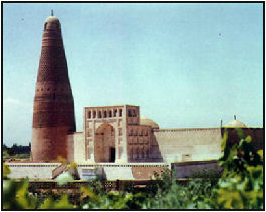 The walls of Turfan.
The walls of Turfan.
Different caravans carried goods over different sections of the route. Traders from the west exchanged thing like gold, wool, horses or jade for silk coming from the east. The caravans stopped at fortresses and oases along the way and passed their loads from trader to trader. As the traders took their cut from the goods and money that changed hands, the price of the goods increased with every transaction.
Walls of Turpan
Very few people traveled the Silk Road from one end to the other. Many of those who traveled the Silk Road were simple traders who took goods from one town or oases to the next and then returned home. Other travelers were caravan leaders or horsemen who earned an income from trading and transporting goods between settled towns.
Walls of Turpan
Very few people traveled the Silk Road from one end to the other. Many of those who traveled the Silk Road were simple traders who took goods from one town or oases to the next and then returned home. Other travelers were caravan leaders or horsemen who earned an income from trading and transporting goods between settled towns.
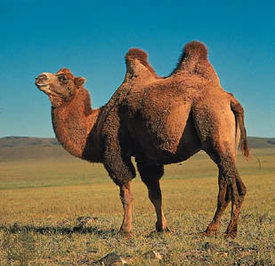 Two-humped Bactrian camel.
Two-humped Bactrian camel.
Silk Road Camels
Bactrian camels were commonly used on the Silk Road to carry goods. Because they could be used in nearly all terrains – from high mountains and cold, open plains to inhospitable deserts – they were indispensable to many traders and remain a big part of Silk Road lore.
Bactrian camels are camels with two humps and two coats of hair. Bactrian camels are capable of carrying 600 pounds. They are native to Central Asia, and a few wild ones still live there. A typical bactrian camel stands six feet tall at the hump. They can weigh as much as half a ton and seem no worse for wear when temperatures drop to -20 degrees F. The fact that they can endure extreme hot and extreme cold temperatures and travel for long periods of time without water made them ideal caravan animals.
Bactrian camels can go a week without water and a month without food. A thirsty camel can drink 25 to 30 gallons of water at one go. For protection against sandstorms, Bactrian camels have two sets of eyelids and eyelashes. The extra eyelids can wipe away sand like windshield wipers. Their nostrils can shrink to a narrow slit to keep out blowing sand.
Bactrian camels were commonly used on the Silk Road to carry goods. Because they could be used in nearly all terrains – from high mountains and cold, open plains to inhospitable deserts – they were indispensable to many traders and remain a big part of Silk Road lore.
Bactrian camels are camels with two humps and two coats of hair. Bactrian camels are capable of carrying 600 pounds. They are native to Central Asia, and a few wild ones still live there. A typical bactrian camel stands six feet tall at the hump. They can weigh as much as half a ton and seem no worse for wear when temperatures drop to -20 degrees F. The fact that they can endure extreme hot and extreme cold temperatures and travel for long periods of time without water made them ideal caravan animals.
Bactrian camels can go a week without water and a month without food. A thirsty camel can drink 25 to 30 gallons of water at one go. For protection against sandstorms, Bactrian camels have two sets of eyelids and eyelashes. The extra eyelids can wipe away sand like windshield wipers. Their nostrils can shrink to a narrow slit to keep out blowing sand.
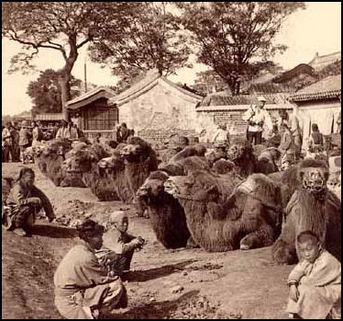 Camel Square.
Camel Square.
The camels’ humps store energy in the form of fat. Each hump can hold 100 pounds of fat and can reach a height of 18 inches. A camel can survive for weeks without food by drawing on the fat from their humps for energy. When a camel doesn’t get enough to eat, it loses the fat and the humps shrink and start to droop
Silk Road Caravans
In a caravan, five to twelve camels are typically roped together head to tail. The caravan leader often rides and even sleeps on the first camel. A bell is tied to the last camel in the line. That way, if the caravan leader dozes off and there is a sudden silence, the leader is alerted that someone may be trying to steal the camel at the end of the line.
Silk Road Caravans
In a caravan, five to twelve camels are typically roped together head to tail. The caravan leader often rides and even sleeps on the first camel. A bell is tied to the last camel in the line. That way, if the caravan leader dozes off and there is a sudden silence, the leader is alerted that someone may be trying to steal the camel at the end of the line.
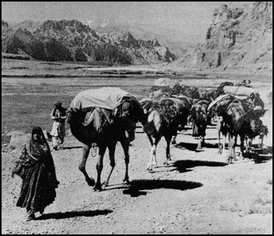
Traveling on the Winter Caravan Through the Pamir Mountains
Temperatures in the Pamir Mountains often drop below -12 degrees Fahrenheit. Because of the cold, the camel drivers wore pointed caps made of heavy, felted wool. The dense felt helped shield the drivers from wind and snow. A cuff around the hat could be rolled down to cover their ears if necessary. The camel drivers protected their hands by wearing heavy garments with extra-long sleeves.
On icy trails sand was packed on the ice to help the animals get a better grip. When the caravan stopped, the camels were prevented from lying down for two hours so they wouldn’t get cold from the snow that was melted by their hot bodies.
Temperatures in the Pamir Mountains often drop below -12 degrees Fahrenheit. Because of the cold, the camel drivers wore pointed caps made of heavy, felted wool. The dense felt helped shield the drivers from wind and snow. A cuff around the hat could be rolled down to cover their ears if necessary. The camel drivers protected their hands by wearing heavy garments with extra-long sleeves.
On icy trails sand was packed on the ice to help the animals get a better grip. When the caravan stopped, the camels were prevented from lying down for two hours so they wouldn’t get cold from the snow that was melted by their hot bodies.
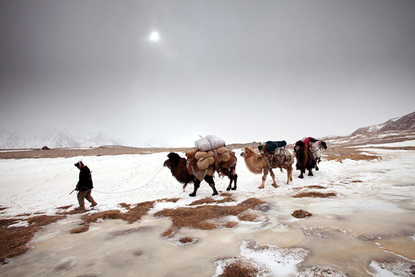
Sometimes the caravans needed to cross frozen rivers where the ice could be as much as three feet thick. Sometimes the caravan’s leaders placed their ears to the ice to listen for weak spots. If they could hear the loud sound of rushing water, then they knew the ice was too thin. Sometimes a heavily loaded animal did break through the ice and drowned or froze to death. Therefore, winter travel always demanded that special care be taken with the heavily loaded camels.
One caravan traveler described a particularly treacherous stretch of mountain trail this way, “On a narrow ledge over a dizzying precipice, my horse slipped and fell on its forelegs. I pulled on the reins and the animal struggled to its feet. Fear dampened my body as we climbed onward … Ahead, a camel slipped and collapsed on the path; it knelt and tried to continue forward by crawling …Risking our lives, we unloaded the animal so that it could regain its footing. Then, we loaded it again and moved on. Even if I did not feel secure, our trade goods were.”
One caravan traveler described a particularly treacherous stretch of mountain trail this way, “On a narrow ledge over a dizzying precipice, my horse slipped and fell on its forelegs. I pulled on the reins and the animal struggled to its feet. Fear dampened my body as we climbed onward … Ahead, a camel slipped and collapsed on the path; it knelt and tried to continue forward by crawling …Risking our lives, we unloaded the animal so that it could regain its footing. Then, we loaded it again and moved on. Even if I did not feel secure, our trade goods were.”
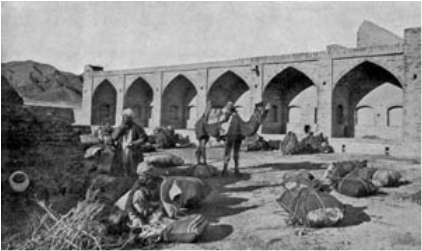 Caravansary interior.
Caravansary interior.
Stops and Caravanserai on the Silk Road
Between towns and oases on the Silk Road, people on long caravans often slept in yurts or under the stars. Stopping places for caravans called Caravanserais sprang up along the routes. The caravansaries offered lodging, stables for the animals, and food. The caravansaries were not all that different from the inexpensive guesthouses or hostels used by backpackers today, except that people stayed for free at the caravansaries. Owners of these rest stops made their money by charging fees for animals and selling meals and supplies to the Silk Road travelers.
Between towns and oases on the Silk Road, people on long caravans often slept in yurts or under the stars. Stopping places for caravans called Caravanserais sprang up along the routes. The caravansaries offered lodging, stables for the animals, and food. The caravansaries were not all that different from the inexpensive guesthouses or hostels used by backpackers today, except that people stayed for free at the caravansaries. Owners of these rest stops made their money by charging fees for animals and selling meals and supplies to the Silk Road travelers.
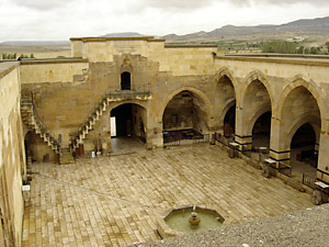 13th century Anatolian caravansary.
13th century Anatolian caravansary.
Caravanserai were often set in small fortresses with guards to protect the caravans from bandits. A typical caravansery was a set of buildings surrounding an open courtyard, where the animals were kept. The animals were tied to wooden stakes. The rates for a stopover and food for the animals depended on the animal. The owners of these rest stops often increased their incomes by gathering manure that was left behind and selling it for fuel and fertilizer. The price for manure was set according to the animal that produced it and how much straw and grass was mixed in. Cow and donkey manure was regarded as high quality because it burned the hottest and kept mosquitoes away.
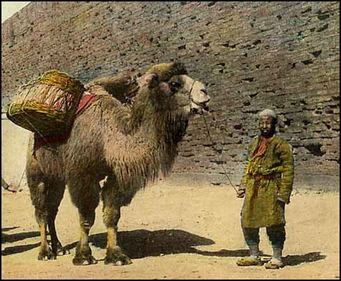
Then as now, traders and travelers had problems with local food and foreign languages. At some stops, they also had to deal with local laws that included such things as bans of certain kinds of native costumes. Often, travelers had to get permits to enter city gates, permits which explained their wants and needs and showed they presented no threat. Of course, those permits also cost the traveler money.
Larger caravans often stayed longer in the larger towns along the routes. While there, caravan leaders rested and fattened up their animals, purchased new animals, relaxed, and sold or traded goods. To meet the caravan’s needs, the Silk Road towns had banks, marketplaces, and a variety of entertainment. Some of the caravan stops became rich cities. That distinction belonged to exotic locales such as Samarkand, Kashgar, Turpan, and Bukhara.
Larger caravans often stayed longer in the larger towns along the routes. While there, caravan leaders rested and fattened up their animals, purchased new animals, relaxed, and sold or traded goods. To meet the caravan’s needs, the Silk Road towns had banks, marketplaces, and a variety of entertainment. Some of the caravan stops became rich cities. That distinction belonged to exotic locales such as Samarkand, Kashgar, Turpan, and Bukhara.

